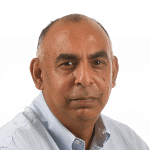Tennis is not all courtesy cars at Grand Slams, "international cuisines" at the players' restaurant, an app to book practice courts and visits from "cute Australian animals". Tennis doesn't always come with an onsite bank, a tax adviser, a creche and a beauty bar.
No, tennis is also smoke.
Smoke that's coming from the wildfires in Napa, California in October last year. A 15-minute drive away in Fairfield, a community college is turned into an evacuation centre, but there's also a Challenger tennis tournament going on.
"The smoke was extremely bad," says Tennys Sandgren, world No. 97, who has quietly crept into the fourth round of the Australian Open. He's in a slight daze (he's never done "back to back to back to back" interviews before), has a ready laugh, is clad in a Metallica T-shirt and owns the easy charm of a dude who lists Unicorns of Love, a professional League of Legends team, as his favourite sports side.
"Some of the refs had masks on... and we saw helicopters dropping water," he says as his coach James Madrigal leans in to show me a picture of a flying supertanker. But the volunteers stayed, the supervisors did their work, and they played on, for they had a living to make and an opportunity to take.
Tennis is more than what you watch on television. It's also this travelling show of unsure talent that scraps hard for a living at events in park recreation centres with "super friendly" people and at country clubs where the members aren't always thrilled that strangers are hogging their courts. "We get looks in the locker room: why are you guys here?," he grins.
Tennis isn't just about a select few who make the Forbes list of highest-paid athletes, it's also players like Sandgren, an American who missed qualifying at the Grand Slams on 13 occasions, who turned pro in 2011 and in his early years says that "a lot of my (annual) prize money was in the US$60,000 (S$79,200) range". Once you subtracted expenses, flights, hotels and US$25 just to string a racket at Challengers, this is how much Sandgren had in his account: "Somewhere between five or 10 (thousand dollars)."
Talent has to be nourished, it has to be fed, tuned, massaged, but not everyone can afford all of it, not everyone can have family beside them regularly on tour or a travelling physio who manages the player's finest asset which is his body.
I ask Madrigal how much it costs for a coach and a trainer and he says roughly "US$80,000 to US$140,000 a year. Plus expenses". Tickets, hotel, food. And so last year, Sandgren, who flies economy, shares a room mostly with Madrigal and can't afford a travelling trainer, earned US$234,368 but in reality made only a "quarter" of that.
"I could do it more bare bones," says Sandgren. "I could travel worse, I could eat worse, I could sleep worse, but it's like at what point do you draw the line and say, well, this is hampering my quality of play... You have to create some level of comfort so you can be in a good place to compete."
But this is the chase they wanted. This is their chosen life. This is their preferred pilgrimage, this mad, insecure, no-guarantee journey to finding the unknown limits of their talent. This is also the lovely honesty of athletes, this understanding that everyone has to grind.
"What's interesting about tennis," he says, "is that when you're a top guy, to get there you have to struggle through the same stuff. You don't have any real advantages per se, it's just you're able to make it through that gauntlet of difficulty. Once you get there and you get more capital behind you, then you can separate yourself even more."
Tennis isn't just the Big Four and the top 10, it's currently 1,981 players ranked on the ATP Tour whose voices you never hear in the arguments for increased prize money. But every raise matters, for it allows them to invest in their future, it helps them play better, it improves the overall product.
This January, at this Open, Sandgren has already won A$240,000 (S$253,700) which is close to what he earned all of last year. He hasn't thought of how he might spend it but he might get a physio on the road more often and he'll certainly give some to his mum, his early coach, "so that she doesn't have to work so damn hard".
And then he'll get back on the rough road where tennis is miles flown in economy, dollars earned, points collected but it's also about dreaming. Oh, wait, he doesn't really know what his is. "I am pursuing whatever my best tennis looks like and I am going to go where that takes me."
Some days into the California smoke, some nights into the lights of Melbourne.

